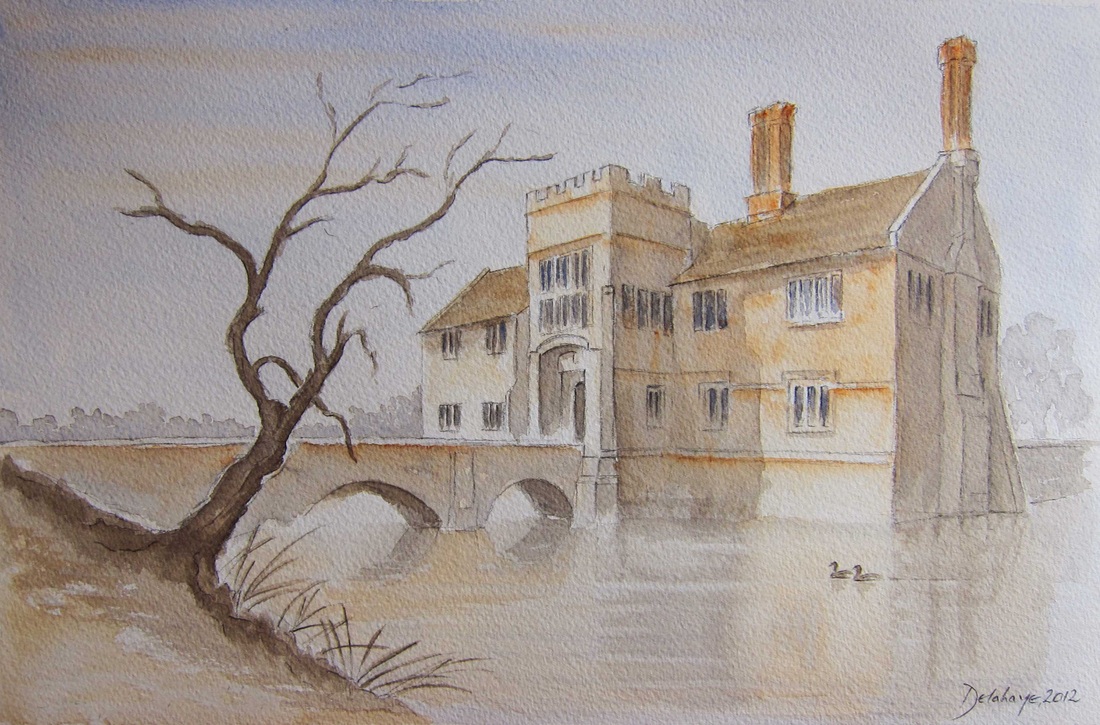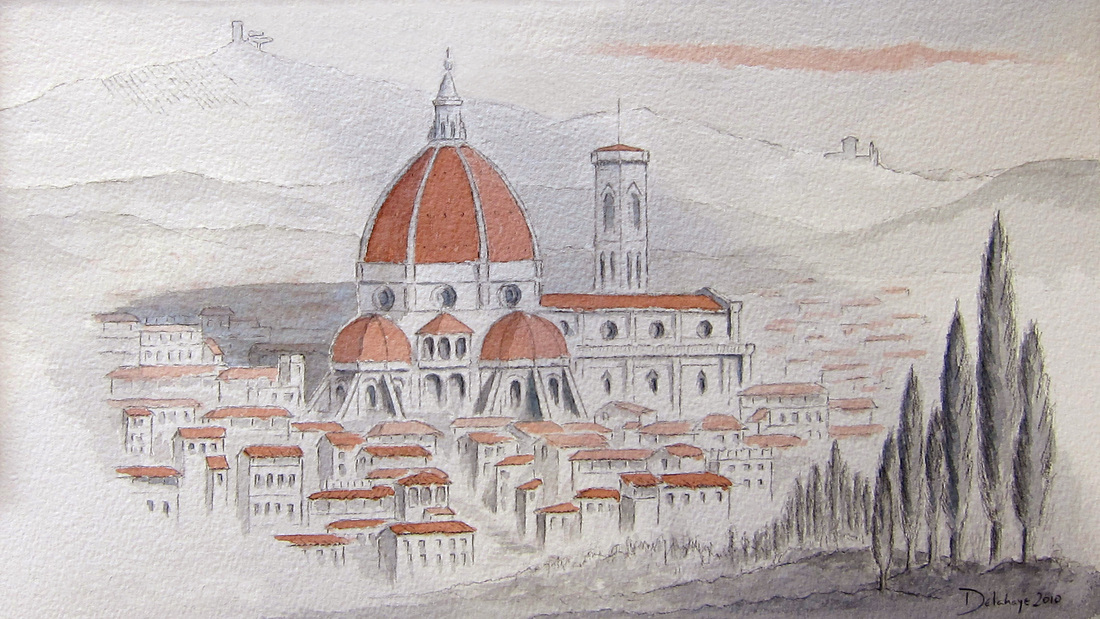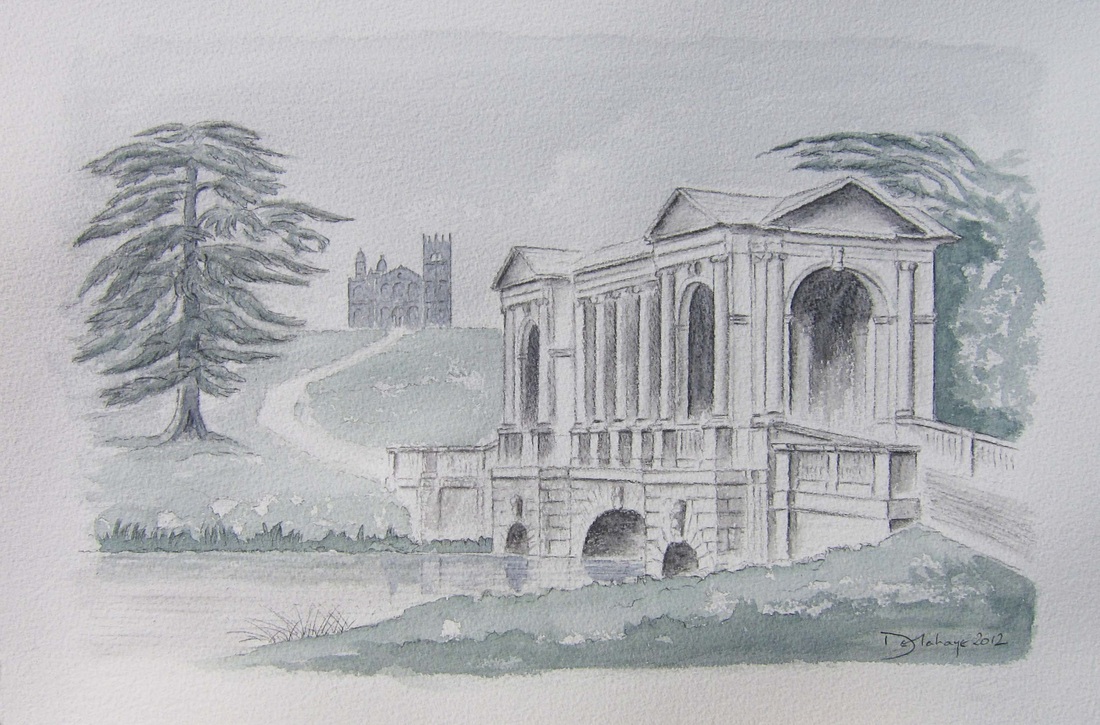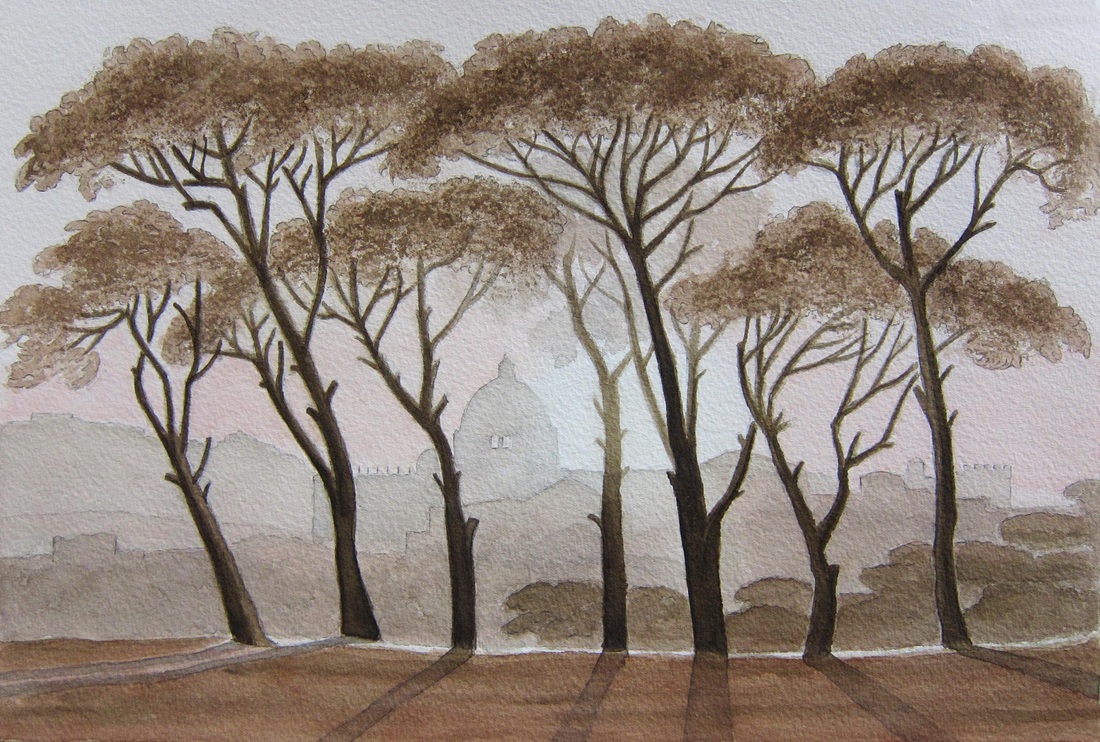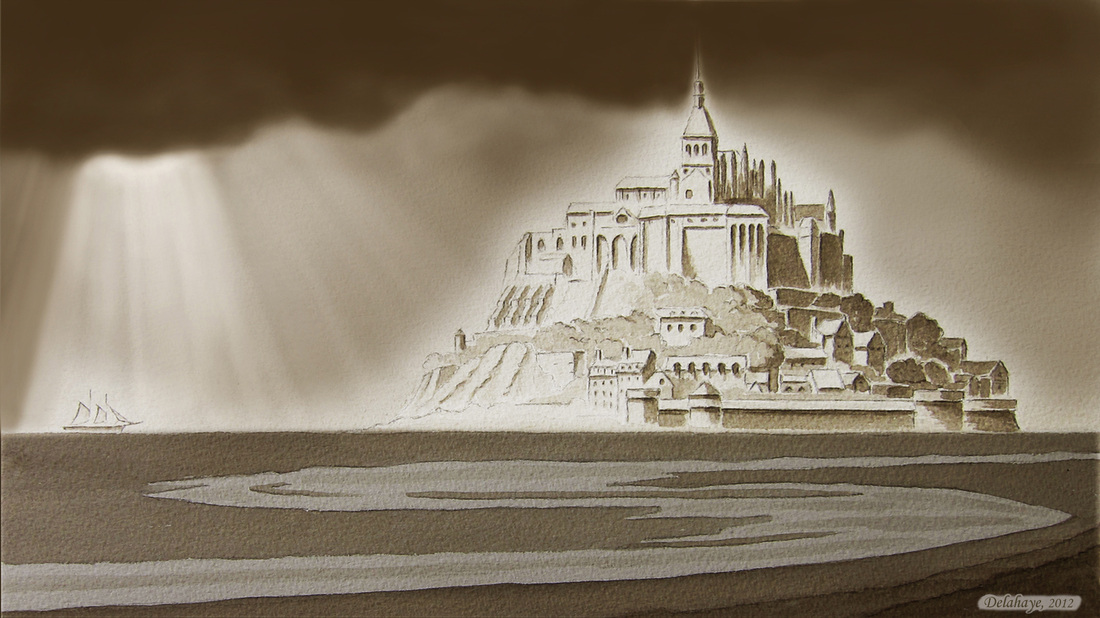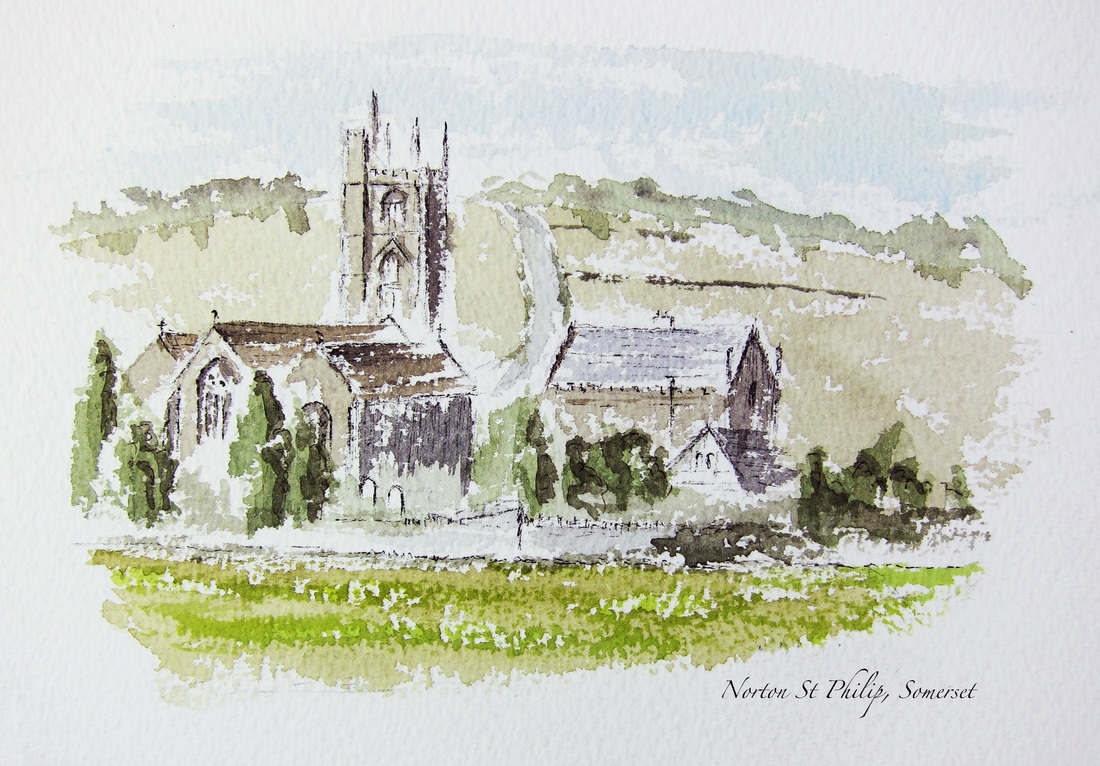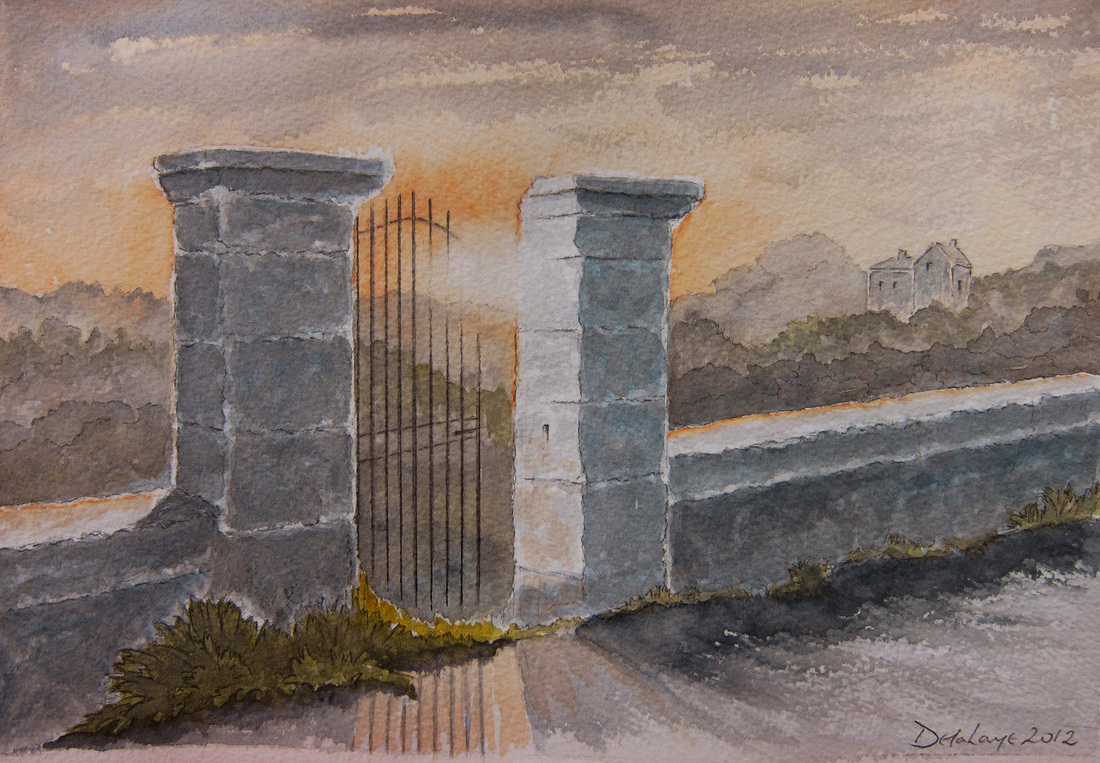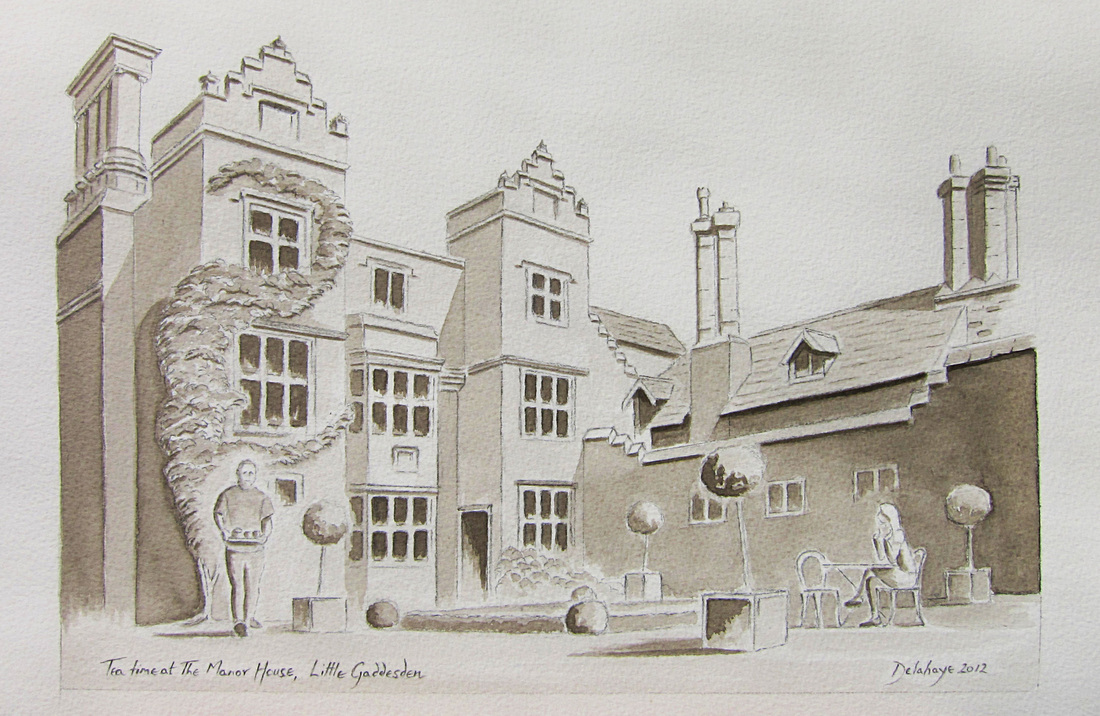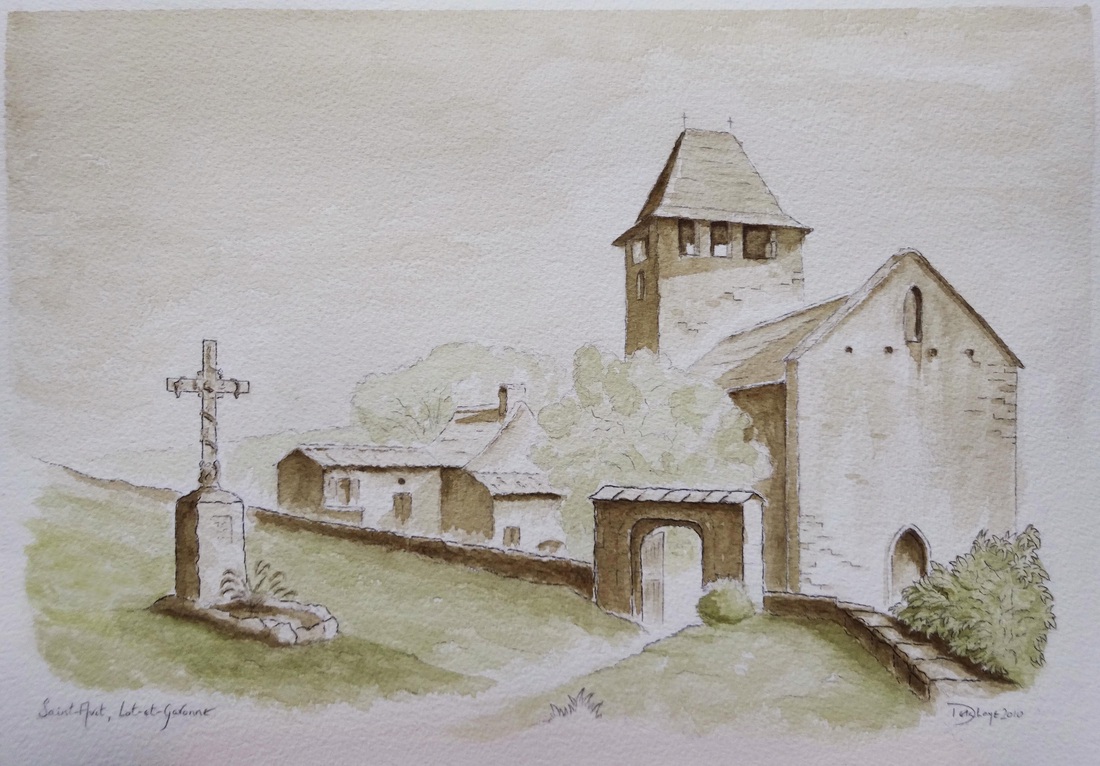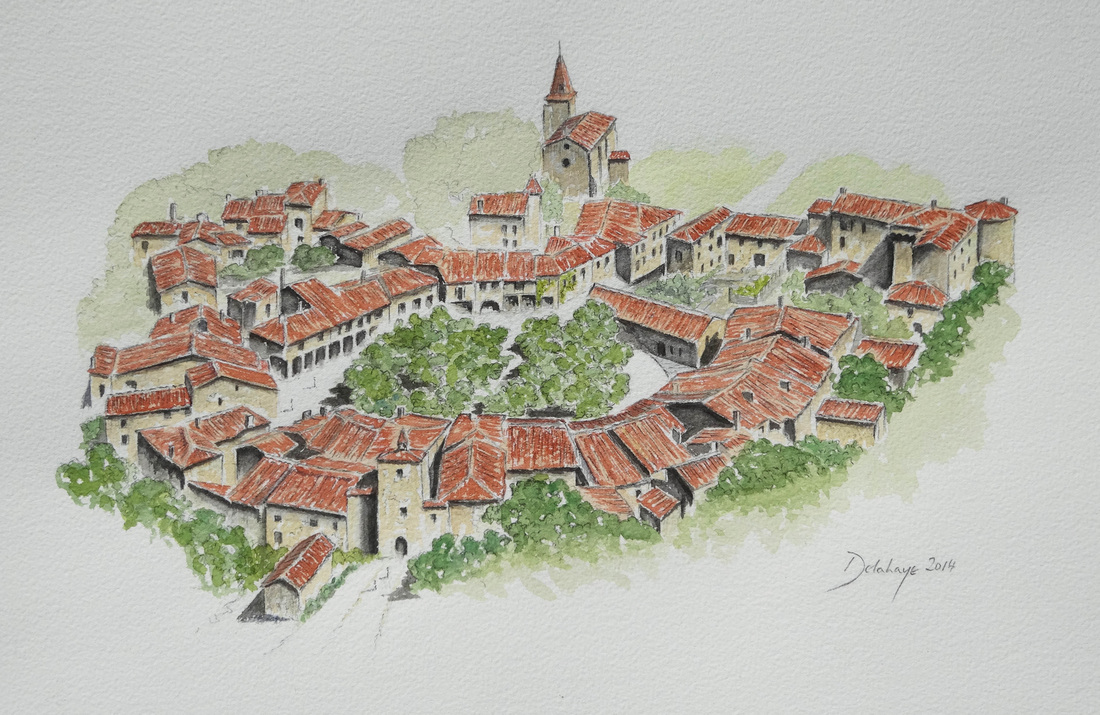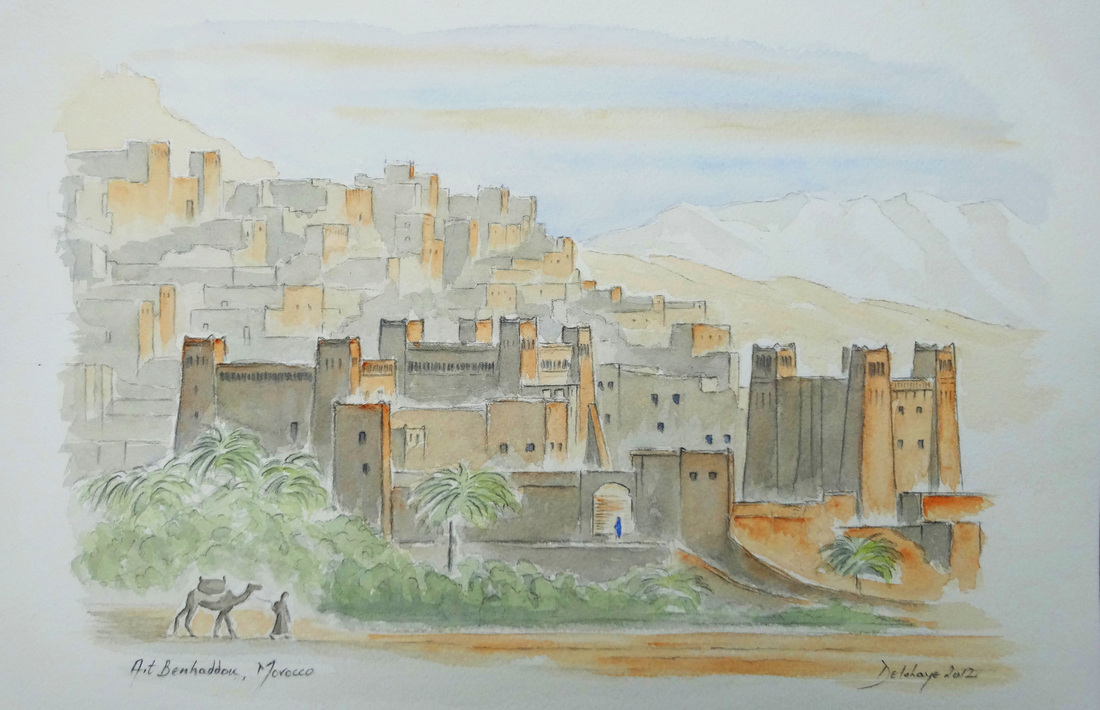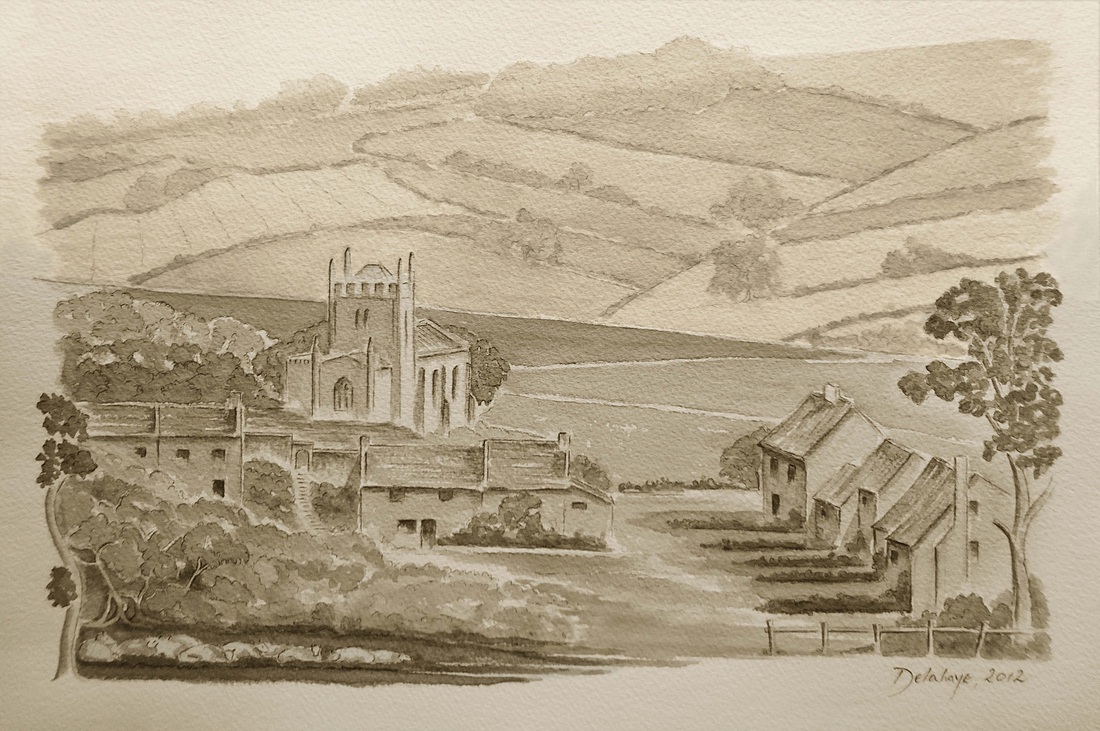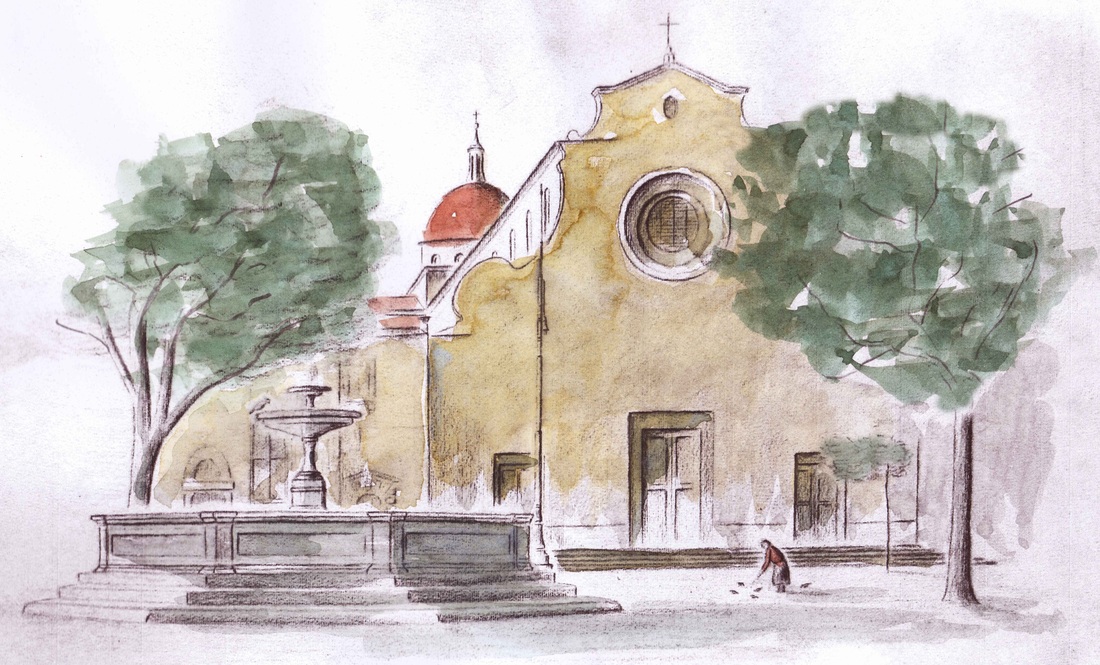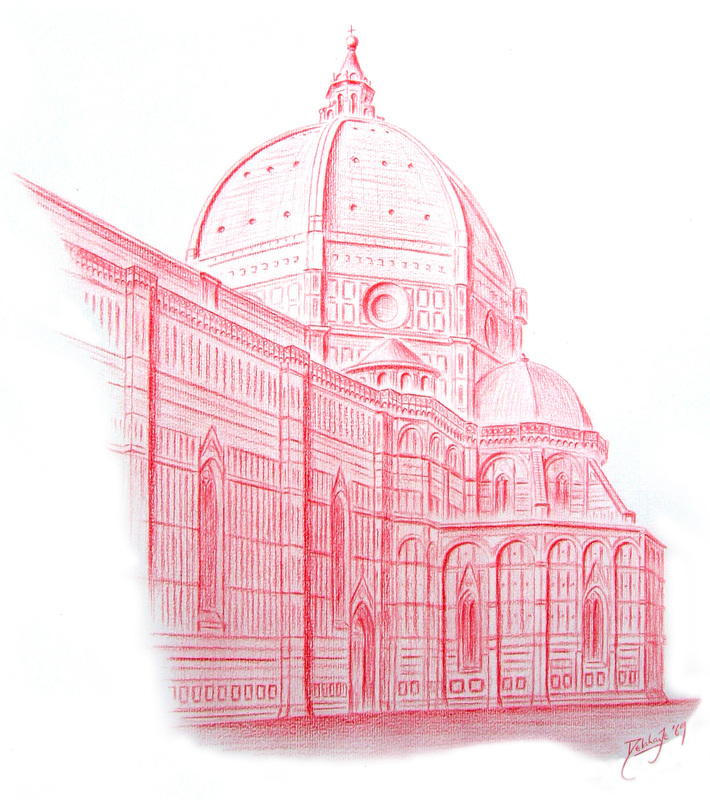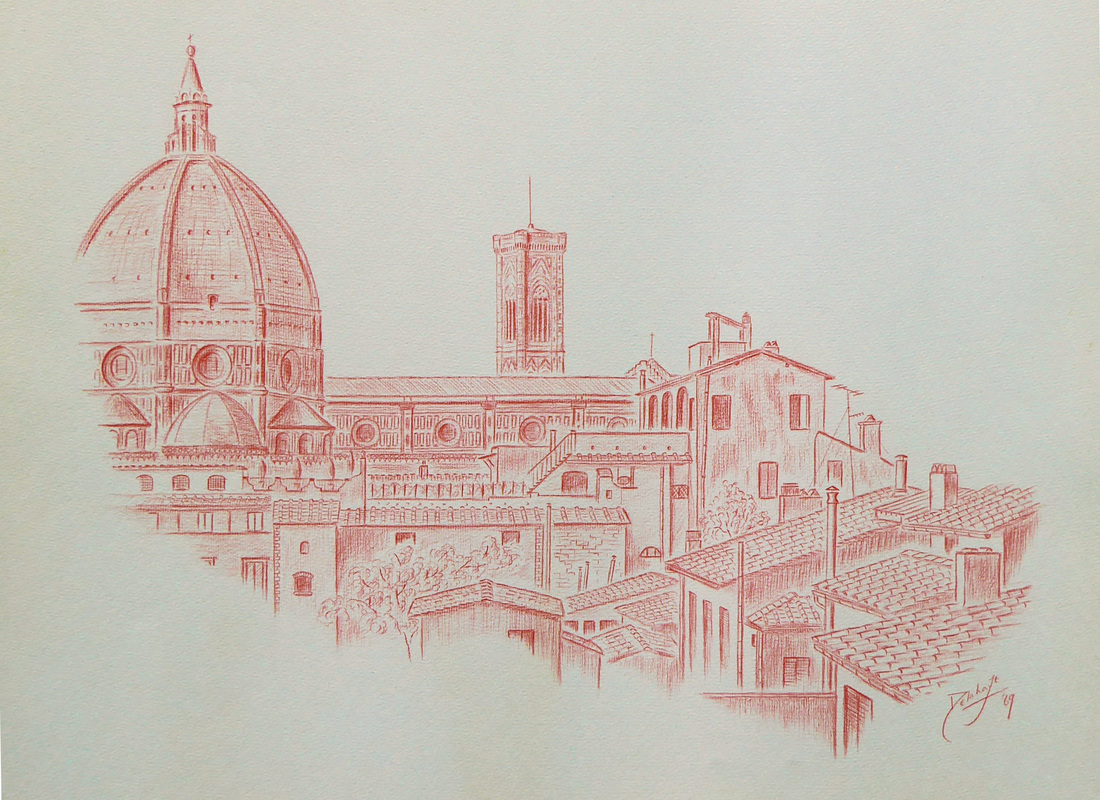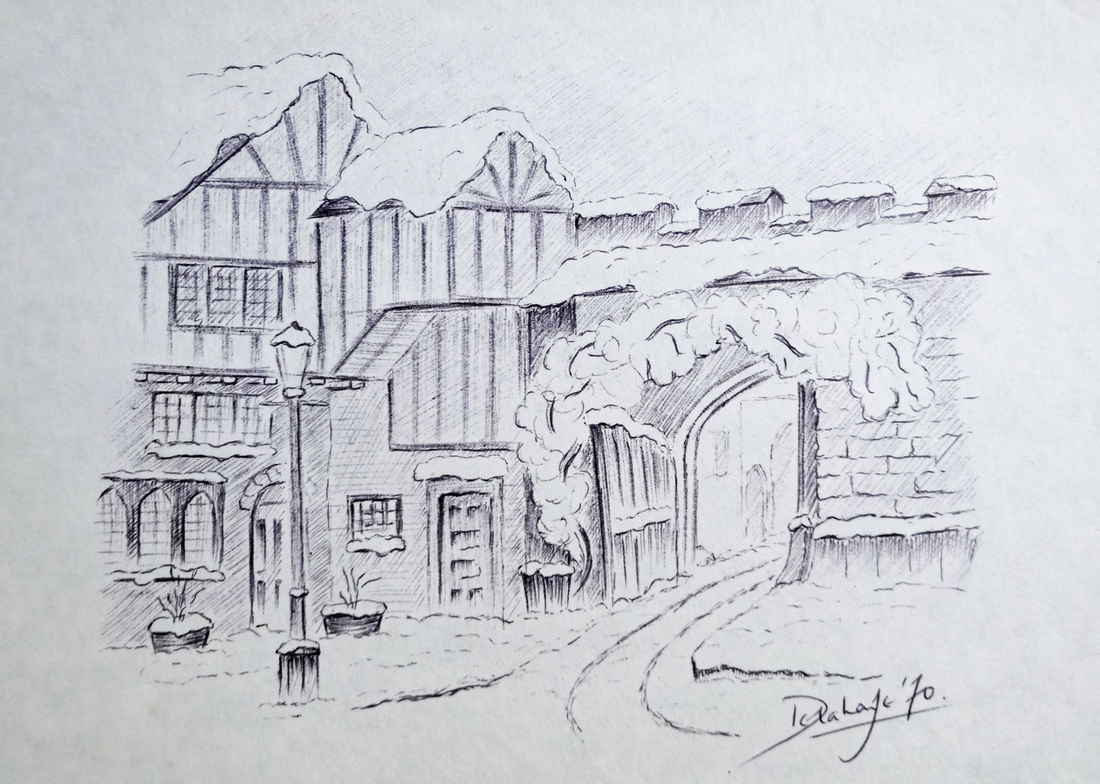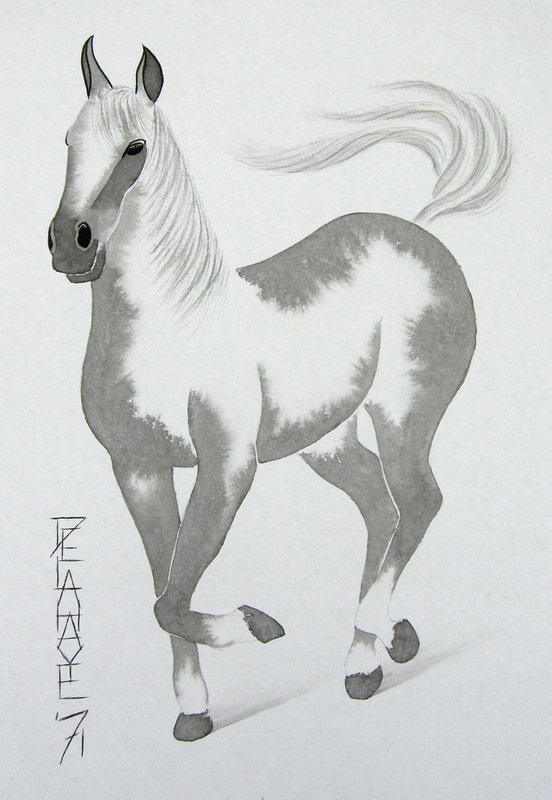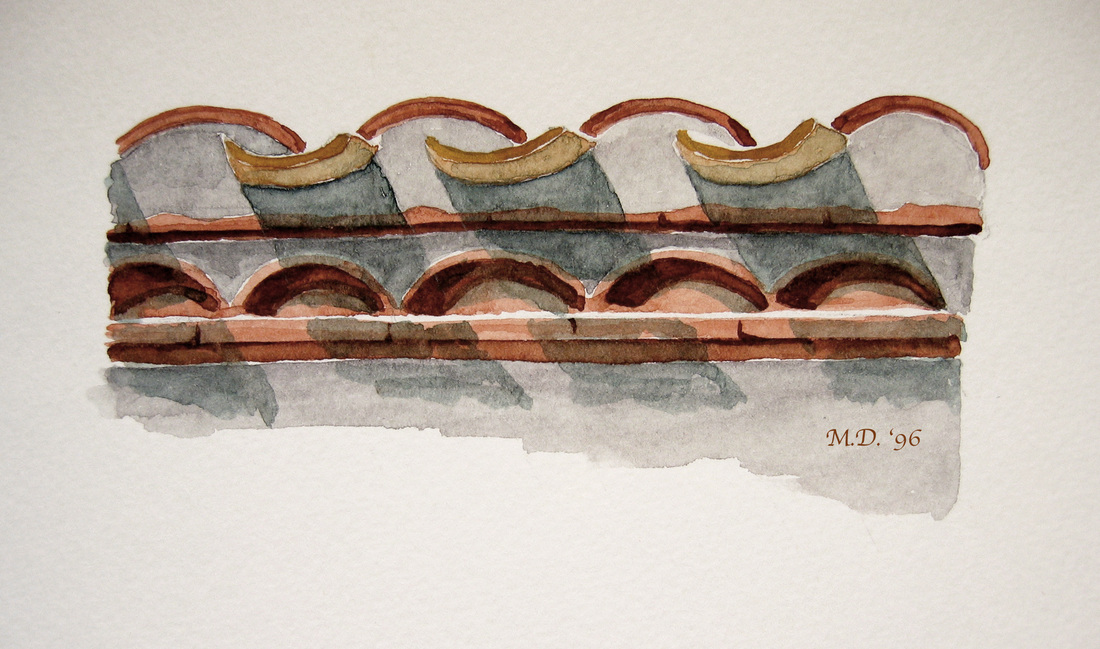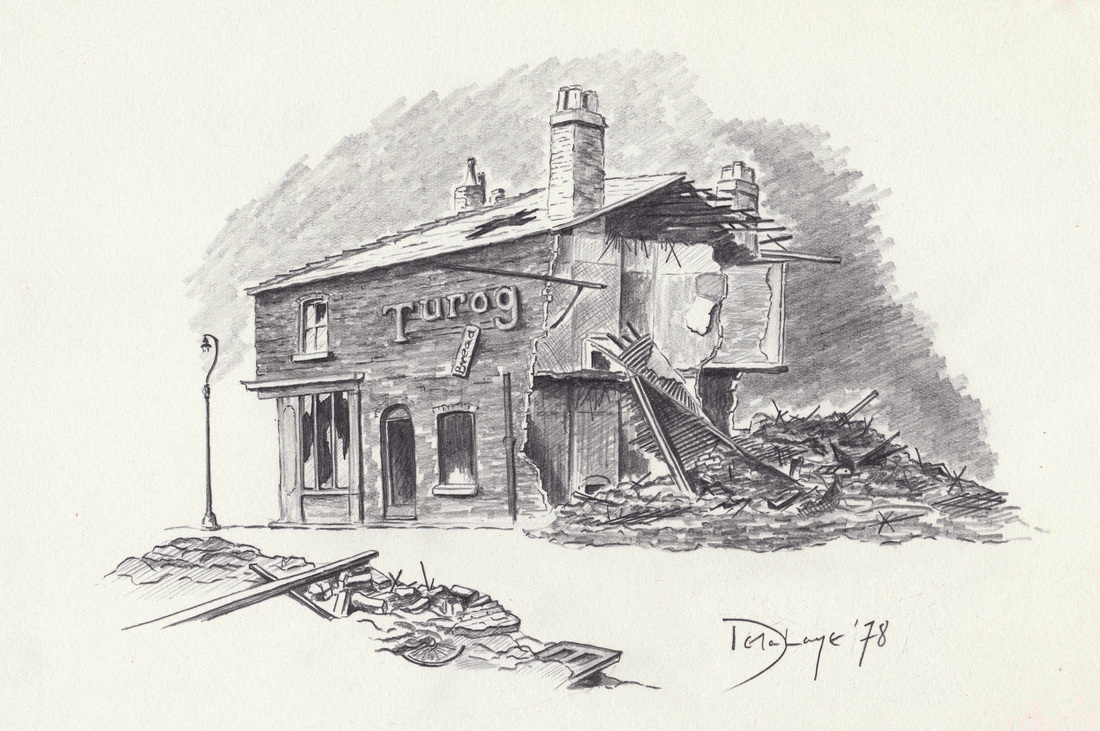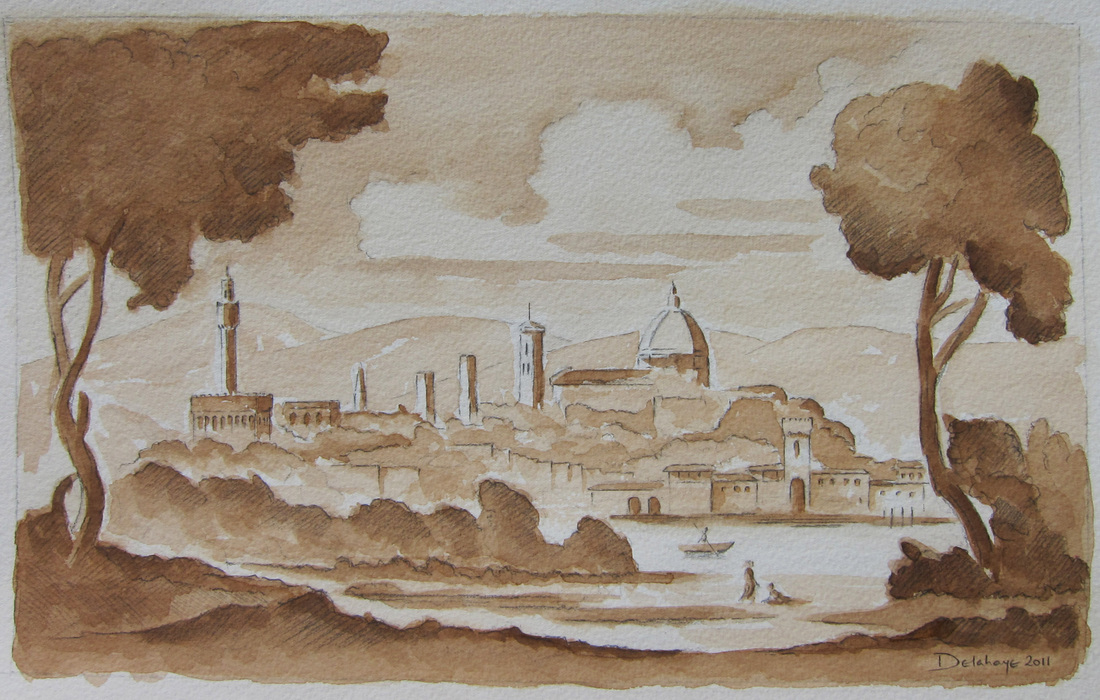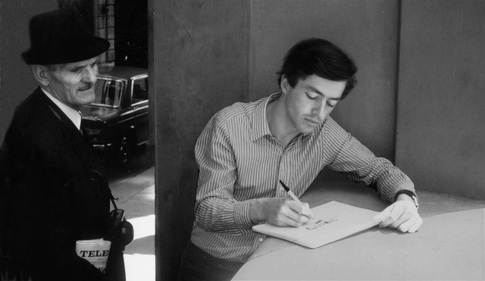
I started drawing and painting in my early twenties while living in Florence and teaching English at the British Institute. It's impossible in a place like Florence not to be inspired - particularly back then before mass tourism when, incredible thought, you could wander through the Uffizi Gallery at your leisure like one of the Medici.
I'm an amateur in both senses of the word - a non-professional practitioner and a lover of the whole process. But, as the dates on the works below will show, I take up my pencils and brushes about once a decade, generally with great enthusiasm - only to abandon them in frustration until the memory of failure fades and I start again. The triumph of hope over experience indeed…
Photo: Anni Delahaye, 1969
PLEASE NOTE: All works are copyright: © Michael Delahaye
I'm an amateur in both senses of the word - a non-professional practitioner and a lover of the whole process. But, as the dates on the works below will show, I take up my pencils and brushes about once a decade, generally with great enthusiasm - only to abandon them in frustration until the memory of failure fades and I start again. The triumph of hope over experience indeed…
Photo: Anni Delahaye, 1969
PLEASE NOTE: All works are copyright: © Michael Delahaye
Baddesley Clinton Manor House, Warwickshire, 2012
Perhaps living in Australia in recent years has made me nostalgic about my homeland - 'You can take the boy out of England but you can't take England out of the boy'. When I'm briefly back there during the European summer, this is the sort of National Trust place I find myself drawn to - all misty moats and mullioned windows. Priest-holes too in this case. Curious, because when I lived in England, I took such places for granted.
Perhaps living in Australia in recent years has made me nostalgic about my homeland - 'You can take the boy out of England but you can't take England out of the boy'. When I'm briefly back there during the European summer, this is the sort of National Trust place I find myself drawn to - all misty moats and mullioned windows. Priest-holes too in this case. Curious, because when I lived in England, I took such places for granted.
Florence, seen from Fiesole, 2010
Florence, once experienced, is a magnet to which one is repeatedly drawn back, physically and metaphorically. This is the Florence of my memory and imagination - Brunelleschi's dome floating above the city like a giant pomander exuding fragrances… of coffee, cooked pasta, leather and drains.
Florence, once experienced, is a magnet to which one is repeatedly drawn back, physically and metaphorically. This is the Florence of my memory and imagination - Brunelleschi's dome floating above the city like a giant pomander exuding fragrances… of coffee, cooked pasta, leather and drains.
The Palladian Bridge, Stowe, 2012
I've written about the history of these Palladian Bridges on my 'Photos' page. There are no fewer than four of them. This is the one at Stowe in Buckinghamshire. I wanted to capture something of the cool neo-classical elegance of the building - hence the muted greys and greens.
I've written about the history of these Palladian Bridges on my 'Photos' page. There are no fewer than four of them. This is the one at Stowe in Buckinghamshire. I wanted to capture something of the cool neo-classical elegance of the building - hence the muted greys and greens.
Rome from the Borghese Gardens, 2012 - after J.R.Cozens, 1782
I'm a fan of the early English watercolour painters - and the original of this painting by J.R. Cozens (in the Whitworth Art Gallery, Manchester) is one of my favourites. It's a masterful study in atmosphere, although its power has been somewhat dulled by the passing centuries. Hence this presumptious exercise in revival. Rather than try slavishly to copy it, I've taken the central section and simplified, concentrating on the way the sun behind St Peter's touches and transforms everything around it - illuminating, bleaching or throwing into stark silhouette. Is it a sunrise or a sunset? If you look at the map, you'll see that St Peter's and the Vatican are west of the Borghese villa and gardens - so clearly the sun is setting.
That said, I'm happy to leave the issue artistically ambiguous; there's more than a suggestion here of Homer's 'rosy-fingered dawn'. To help determine your own preference, take a look at the original: https://www.artfund.org/what-we-do/art-weve-helped-buy/artwork/2266/st-peters-from-the-villa-borghese-rome-john-robert-cozens
I'm a fan of the early English watercolour painters - and the original of this painting by J.R. Cozens (in the Whitworth Art Gallery, Manchester) is one of my favourites. It's a masterful study in atmosphere, although its power has been somewhat dulled by the passing centuries. Hence this presumptious exercise in revival. Rather than try slavishly to copy it, I've taken the central section and simplified, concentrating on the way the sun behind St Peter's touches and transforms everything around it - illuminating, bleaching or throwing into stark silhouette. Is it a sunrise or a sunset? If you look at the map, you'll see that St Peter's and the Vatican are west of the Borghese villa and gardens - so clearly the sun is setting.
That said, I'm happy to leave the issue artistically ambiguous; there's more than a suggestion here of Homer's 'rosy-fingered dawn'. To help determine your own preference, take a look at the original: https://www.artfund.org/what-we-do/art-weve-helped-buy/artwork/2266/st-peters-from-the-villa-borghese-rome-john-robert-cozens
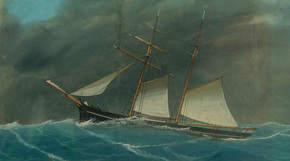
Le Mont Saint Michel, 2012
The Mont Saint Michel is about 60 kilometres from the Channel island of Jersey where my mother was born and where, as a child, I spent many idyllic family holidays. A few years ago, on a return visit to the island, I discovered that my great-grandfather George De La Haye, born in 1847, had not only been a potato farmer but, during the off-season, had acted as the Chief Officer on a two-masted schooner called 'The Comet of Jersey' (see right) which regularly criss-crossed the Atlantic Ocean to fish for cod off the Grand Banks of Newfoundland. So here's George's schooner returning to home port - though, in deference to his maritime skills, I should admit to some artistic licence. If he'd been on this particular bearing, he'd have missed Jersey and beached on the sand banks.
Contemporary painting courtesy of Jane Jones, Jersey
The Mont Saint Michel is about 60 kilometres from the Channel island of Jersey where my mother was born and where, as a child, I spent many idyllic family holidays. A few years ago, on a return visit to the island, I discovered that my great-grandfather George De La Haye, born in 1847, had not only been a potato farmer but, during the off-season, had acted as the Chief Officer on a two-masted schooner called 'The Comet of Jersey' (see right) which regularly criss-crossed the Atlantic Ocean to fish for cod off the Grand Banks of Newfoundland. So here's George's schooner returning to home port - though, in deference to his maritime skills, I should admit to some artistic licence. If he'd been on this particular bearing, he'd have missed Jersey and beached on the sand banks.
Contemporary painting courtesy of Jane Jones, Jersey
Norton St Philip, Somerset - ink & watercolour, 2012. About as 'English' as it gets. My intention was to 'skate' the brush across the heavily textured surface and leave as much exposed paper as possible so as to create the effect of an impressionistic sketch. With hindsight, I realise the style I had in mind, if only subconsciously, was that of the artist John Piper. Very much Piper's sort of subject matter too.
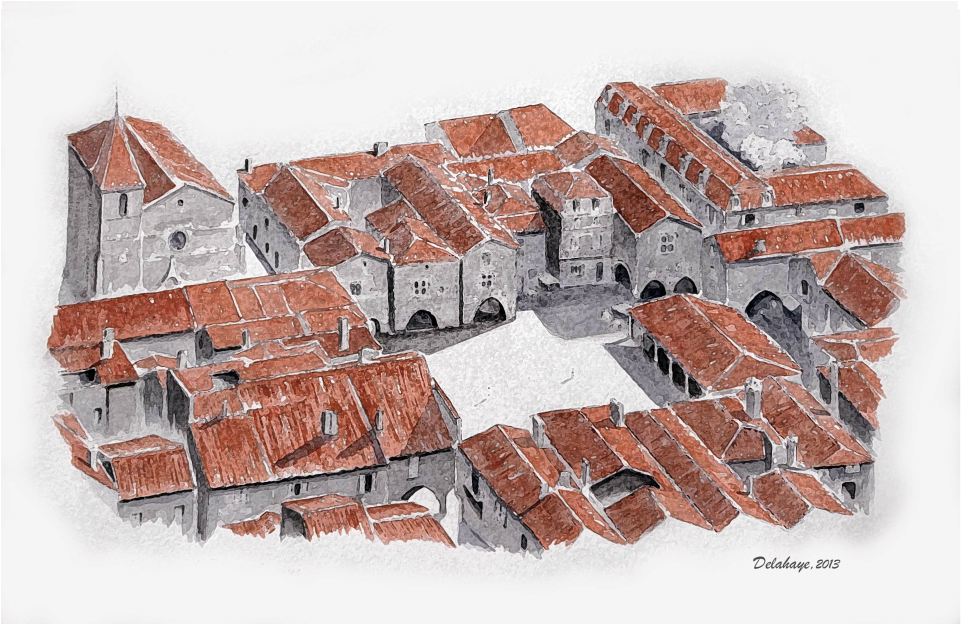
La Place des Cornières, Monpazier, Dordogne, 2013
Monpazier is a medieval 'bastide' founded in 1284 where my wife and I were fortunate - privileged - to live for several years. The stones and tiles resonate with history. Its focal glory, shown above, is its main square, la Place des Cornières. A market has been held here every Thursday for the past seven hundred years. If you put your mind to it, you can spend the entire day in the square, following the sun around from one watering hole to another. Because of the sheltering arcades - the 'cornières' - you could even do it in the rain.
Monpazier is a medieval 'bastide' founded in 1284 where my wife and I were fortunate - privileged - to live for several years. The stones and tiles resonate with history. Its focal glory, shown above, is its main square, la Place des Cornières. A market has been held here every Thursday for the past seven hundred years. If you put your mind to it, you can spend the entire day in the square, following the sun around from one watering hole to another. Because of the sheltering arcades - the 'cornières' - you could even do it in the rain.
Monpazier… again. Sunset. This old stone gate on the west side of the bastide overlooks the woods where in medieval times the locals would go and forage for sweet chestnuts. Long before truffles became fashionable.
Tea time at The Manor House, Little Gaddesden, Buckinghamshire, sepia ink, 2012
It's always handy to have friends who own an English manor house - or at least the most interesting part of one. Gaddesden Manor was built during the reign of Elizabeth Ist, in 1576. Few things are more civilised than tea in the knot garden… or, failing that, overlooking the croquet lawn.
It's always handy to have friends who own an English manor house - or at least the most interesting part of one. Gaddesden Manor was built during the reign of Elizabeth Ist, in 1576. Few things are more civilised than tea in the knot garden… or, failing that, overlooking the croquet lawn.
St-Avit, Lot-et-Garonne, France, 2010
There can't be many more peaceful places on earth than the small walled cemetery at St-Avit. In the spirit of the confessional, though, I should admit to a minor exhumation. In order to balance the composition, I've moved the grave several metres and turned it through 180 degrees. But, apart from that…
There can't be many more peaceful places on earth than the small walled cemetery at St-Avit. In the spirit of the confessional, though, I should admit to a minor exhumation. In order to balance the composition, I've moved the grave several metres and turned it through 180 degrees. But, apart from that…
The Bastide of Fourcès, Gers, France, 2014
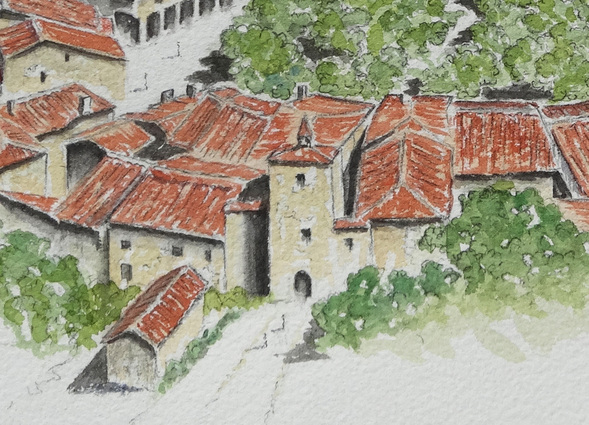
Fourcès is an unusual bastide - it’s circular. There are a number of these 'circulades' in South West France; they even have their own club. According to some historians, they pre-date the conventional rectangular-grid bastides by a century or two and have a claim to being Europe’s first urban settlements. The circular configuration makes sense, enabling the houses to double as defensive walls; the more concentric rings radiating from the centre, the greater the protection against attackers.
Ait Benhaddou, Morocco, 2012
Despite working in a number of Arab countries, I've never been to Morocco - but Ait Benhaddou has long fascinated me. Judged by the photos, it seems to be a city built entirely of mud - the centuries-old 'skyscrapers' included. It rises, organically, out the ground that provides its raw material. One day…
Despite working in a number of Arab countries, I've never been to Morocco - but Ait Benhaddou has long fascinated me. Judged by the photos, it seems to be a city built entirely of mud - the centuries-old 'skyscrapers' included. It rises, organically, out the ground that provides its raw material. One day…
Englishcombe, just outside Bath, Somerset, UK, 2013
The village sits on the very edge of an escarpment, the fields beyond appearing as a distant, rather theatrical backdrop. Hence the sharp divide in tone and intensity between mid-ground and background. As for the immediate foreground, it's a case of Arts & Crafts meets The Willow Pattern.
The village sits on the very edge of an escarpment, the fields beyond appearing as a distant, rather theatrical backdrop. Hence the sharp divide in tone and intensity between mid-ground and background. As for the immediate foreground, it's a case of Arts & Crafts meets The Willow Pattern.
Piazza Santo Spirito, Florence, 1969/2011
Never abandon a picture… This was originally a red Conté pencil drawing which I did, sitting in the piazza, back in 1969. For some reason, it looked lifeless and I consigned it to my 'failure folder'. Forty-two years later, trying to find a subject for a Christmas card, I came across it again. It was still lifeless but I photocopied it in black and white, sloshed some watercolours over the copy and, like Frankenstein's monster, it sparked into life.
Never abandon a picture… This was originally a red Conté pencil drawing which I did, sitting in the piazza, back in 1969. For some reason, it looked lifeless and I consigned it to my 'failure folder'. Forty-two years later, trying to find a subject for a Christmas card, I came across it again. It was still lifeless but I photocopied it in black and white, sloshed some watercolours over the copy and, like Frankenstein's monster, it sparked into life.
The Duomo, Florence, Conté crayon, 1969
In terms of art appreciation, this was my Eureka moment - when I realised how a Conté crayon drawn across a sheet of grained paper could produce a convincingly three-dimensional image. It took two days, sitting on the steps of the Misericordia Ambulance service, squinting up at the Duomo and, in effect, rebuilding it on paper from the ground up. By the end - bottom numb, neck cricked - I fancied I had an inkling of how Brunelleschi must have felt.
In terms of art appreciation, this was my Eureka moment - when I realised how a Conté crayon drawn across a sheet of grained paper could produce a convincingly three-dimensional image. It took two days, sitting on the steps of the Misericordia Ambulance service, squinting up at the Duomo and, in effect, rebuilding it on paper from the ground up. By the end - bottom numb, neck cricked - I fancied I had an inkling of how Brunelleschi must have felt.
The Duomo, Florence, Conté crayon, 1969
The panoramic view from the tiny top-floor apartment in the Via Ricasoli which my wife-to-be and I rented when living and working in Florence. It was actually the view from the bathroom. All very inspiring, you may think - until Anni realised, sitting there, that if she could see the tourists on the top of Giotto's Tower, they could see her…
The panoramic view from the tiny top-floor apartment in the Via Ricasoli which my wife-to-be and I rented when living and working in Florence. It was actually the view from the bathroom. All very inspiring, you may think - until Anni realised, sitting there, that if she could see the tourists on the top of Giotto's Tower, they could see her…
The 15th century Priory Gate in winter, Winchester, England, 1970
Pure sentimentality. Winchester is my 'home city' - I was born ten miles outside. Jane Austen lived her last days in a house just through the gate (she died in 1817 and is buried in Winchester Cathedral) and, if you walk another couple of hundred yards past Winchester College, you will come to the water meadows where, two years later, John Keats composed 'To Autumn' ('Season of mists and mellow fruitfulness…'). As though that weren't enough historical associations, Winchester was the capital of Saxon England at the time of King Alfred the Great.
Pure sentimentality. Winchester is my 'home city' - I was born ten miles outside. Jane Austen lived her last days in a house just through the gate (she died in 1817 and is buried in Winchester Cathedral) and, if you walk another couple of hundred yards past Winchester College, you will come to the water meadows where, two years later, John Keats composed 'To Autumn' ('Season of mists and mellow fruitfulness…'). As though that weren't enough historical associations, Winchester was the capital of Saxon England at the time of King Alfred the Great.
Prancing horse, 1971
An exercise in 'wet-in-wet' technique using 'Encre de Chine'. Since I've always been better at buildings than people or animals, I suspect I copied the horse's stance from a Chinese original. The truth is out there, lurking in some dark corner of the Internet, waiting to expose me as a fraud, a faker and - ultimate shame - a pictorial plagiarist!
An exercise in 'wet-in-wet' technique using 'Encre de Chine'. Since I've always been better at buildings than people or animals, I suspect I copied the horse's stance from a Chinese original. The truth is out there, lurking in some dark corner of the Internet, waiting to expose me as a fraud, a faker and - ultimate shame - a pictorial plagiarist!
Roof tiles, Pujols, France, 1996
Terracotta tiles and deep shadows - a combination that for me always evokes hot summers in what the Brits still call 'continental' Europe…
Terracotta tiles and deep shadows - a combination that for me always evokes hot summers in what the Brits still call 'continental' Europe…
Manchester demolition, pencil drawing, 1978
Just to prove I'm not an artistic snob drawn exclusively to cathedrals, manor houses and neo-classical gems… During the 1970s I lived and worked in Manchester (as a reporter for the BBC's 'Look North' programme) when great swathes of the city were being bulldozed. I actually 'liberated' the iconic TUROG sign and for many years it hung on the living-room wall… until, as in the picture, the 'Bread' bit fell off.
Just to prove I'm not an artistic snob drawn exclusively to cathedrals, manor houses and neo-classical gems… During the 1970s I lived and worked in Manchester (as a reporter for the BBC's 'Look North' programme) when great swathes of the city were being bulldozed. I actually 'liberated' the iconic TUROG sign and for many years it hung on the living-room wall… until, as in the picture, the 'Bread' bit fell off.
'Veduta ideata' of Florence, sepia, 2011
Frankly, this is not my finest work… It's flat, two-dimensional and needs a bit of life breathing into it. BUT it is the end product of a bizarre story of 'lost and found', while also exemplifying the fallibility of memory.
Sometime in the mid-1970s I was (yet again) in Florence. As I walked down the Borgo San Jacopo which runs along the south bank of the River Arno close to the Ponte Vecchio, I was struck by a small pen-and-wash picture in the window of an antiquarian. The style suggested it was mid-eighteenth century. There was something striking about it, something about the perfect balance of the composition, its ability to encompass an entire world and, not least, the fact that it had been rendered in understated monochrome sepia. I wanted it.
Guessing I wouldn't be able to afford it, I asked the price. I was right. It was so much that I can't now remember the figure because I instantly dismissed it. But that afternoon during the siesta period when the shop was closed, I returned and sneaked a photo through the window.
Decades passed and, while I always remembered the painting (or thought I did; more later), I completely forgot about the photo.
Fast forward thirty-five years, half a lifetime. It’s November 2011. I’m here in Adelaide and sifting through half a dozen cardboard boxes of photos and negatives, accumulated over the decades. Time for a sort-out. And there, in the second box I open, it is - the photo I'd taken through the grille of the antiquarian's window...
Frankly, this is not my finest work… It's flat, two-dimensional and needs a bit of life breathing into it. BUT it is the end product of a bizarre story of 'lost and found', while also exemplifying the fallibility of memory.
Sometime in the mid-1970s I was (yet again) in Florence. As I walked down the Borgo San Jacopo which runs along the south bank of the River Arno close to the Ponte Vecchio, I was struck by a small pen-and-wash picture in the window of an antiquarian. The style suggested it was mid-eighteenth century. There was something striking about it, something about the perfect balance of the composition, its ability to encompass an entire world and, not least, the fact that it had been rendered in understated monochrome sepia. I wanted it.
Guessing I wouldn't be able to afford it, I asked the price. I was right. It was so much that I can't now remember the figure because I instantly dismissed it. But that afternoon during the siesta period when the shop was closed, I returned and sneaked a photo through the window.
Decades passed and, while I always remembered the painting (or thought I did; more later), I completely forgot about the photo.
Fast forward thirty-five years, half a lifetime. It’s November 2011. I’m here in Adelaide and sifting through half a dozen cardboard boxes of photos and negatives, accumulated over the decades. Time for a sort-out. And there, in the second box I open, it is - the photo I'd taken through the grille of the antiquarian's window...
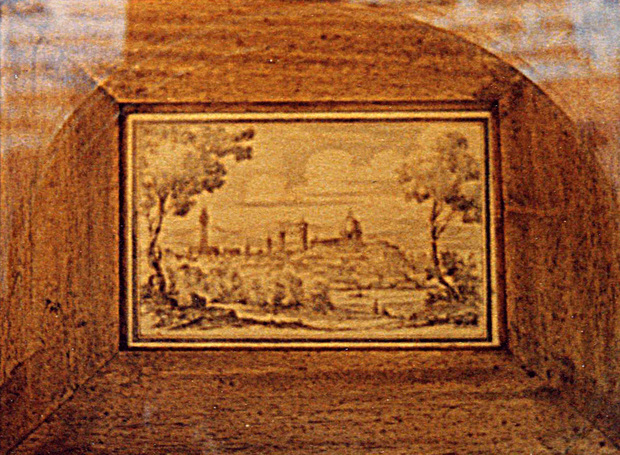
It's small, just five by three-and-a-half inches, and there's no negative with it. And, because it had necessarily to be taken from a distance without the benefit of a zoom, the sepia picture itself is no bigger than a postage stamp. But the image - at least the composition and its main components - is clear enough.
And here’s the surprising thing… It’s not the image that I’d remembered all those years. What I recalled was one of those classic views of Florence from the elevated level of the Piazzale Michelangelo – with the River Arno in the foreground and the Duomo, Giotto’s Tower and the Palazzo della Signoria spread out beyond and below. But, when I examine the photographic image more closely through a magnifying glass, I see that this is actually a ‘capriccio’ or ‘veduta ideata’ – an idealized view. It’s a work of the imagination. The artist’s point of view is low, from the south bank of the Arno. It looks across – and up – to a mound that is topped by the Duomo and Giotto’s Tower. Florence has magically become ‘a shining city upon a hill’ - as though an earthquake has raised it a couple of hundred feet. The devastating floods of 1966 would never have touched it. Off to the left are the Palazzo della Signoria with its distinctive bell-tower and, in its shadow, the church of Orsanmichele.
The landmarks are all there – but their orientation has been tweaked for greater effect and what, topographically, should be a saucer-shaped depression has been flipped and become a raised plateau. The composition is clever and curiously satisfying. It’s both familiar – with all the well-known bits – and refreshing because they’re not as we’re used to seeing them. It’s a brilliant reworking of a traditional, almost hackneyed view.
My original intention had been to make a copy of the original, as accurately as possible. But, as I built up the washes, an artistic independence asserted itself. The focus of attention of the composition, rightly, is the Duomo. The viewer’s eye travels from the bottom right-hand corner to a pair of figures on the shoreline, thence across the glistening expanse of river, via a small boat, to the other side, from where it climbs up to the Duomo, crowned by Brunelleschi’s distinctive cupola.
The problem was that I couldn’t see from the tiny photo - or remember - what the original artist had depicted on the far shoreline. Was it a man-made structure of some sort (there’s the suggestion of a long, low building, perhaps two) or just a mass of generic vegetation? My strong feeling was that the eye required some sort of ‘staging post’ or ‘base camp’ before making the steep ascent to the Duomo. What suggested itself was a maritime gate with buildings either side and steps leading up from the river. And for good measure a few mooring posts off to the right.
Whether my addition is accurate or not, I don’t know - but it feels right. If anybody has ever seen - or acquired - the original, I'd be fascinated to know the truth. Get in touch! If you own it, I might even make you an offer.
And here’s the surprising thing… It’s not the image that I’d remembered all those years. What I recalled was one of those classic views of Florence from the elevated level of the Piazzale Michelangelo – with the River Arno in the foreground and the Duomo, Giotto’s Tower and the Palazzo della Signoria spread out beyond and below. But, when I examine the photographic image more closely through a magnifying glass, I see that this is actually a ‘capriccio’ or ‘veduta ideata’ – an idealized view. It’s a work of the imagination. The artist’s point of view is low, from the south bank of the Arno. It looks across – and up – to a mound that is topped by the Duomo and Giotto’s Tower. Florence has magically become ‘a shining city upon a hill’ - as though an earthquake has raised it a couple of hundred feet. The devastating floods of 1966 would never have touched it. Off to the left are the Palazzo della Signoria with its distinctive bell-tower and, in its shadow, the church of Orsanmichele.
The landmarks are all there – but their orientation has been tweaked for greater effect and what, topographically, should be a saucer-shaped depression has been flipped and become a raised plateau. The composition is clever and curiously satisfying. It’s both familiar – with all the well-known bits – and refreshing because they’re not as we’re used to seeing them. It’s a brilliant reworking of a traditional, almost hackneyed view.
My original intention had been to make a copy of the original, as accurately as possible. But, as I built up the washes, an artistic independence asserted itself. The focus of attention of the composition, rightly, is the Duomo. The viewer’s eye travels from the bottom right-hand corner to a pair of figures on the shoreline, thence across the glistening expanse of river, via a small boat, to the other side, from where it climbs up to the Duomo, crowned by Brunelleschi’s distinctive cupola.
The problem was that I couldn’t see from the tiny photo - or remember - what the original artist had depicted on the far shoreline. Was it a man-made structure of some sort (there’s the suggestion of a long, low building, perhaps two) or just a mass of generic vegetation? My strong feeling was that the eye required some sort of ‘staging post’ or ‘base camp’ before making the steep ascent to the Duomo. What suggested itself was a maritime gate with buildings either side and steps leading up from the river. And for good measure a few mooring posts off to the right.
Whether my addition is accurate or not, I don’t know - but it feels right. If anybody has ever seen - or acquired - the original, I'd be fascinated to know the truth. Get in touch! If you own it, I might even make you an offer.
